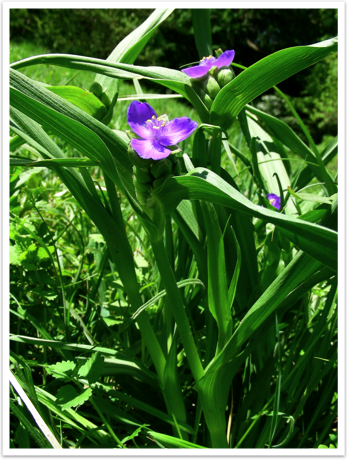Like Spring Beauty, Spiderwort was brought back to the old world during the early days of European-American botany. The genus is named after the John Tradescants (that is, JT the elder and JT the younger). The elder was a contemporary of Shakespeare and royal gardener, a position which entailed considerable adventure and travel; his son followed him in his name, passions and occupation. Their collection of rarities, acquired by Elias Ashmole under questionable circumstances involving mysterious deaths and contested wills, form the basis of the famous Ashmolean Museum.
Although Spiderwort is both a wild and garden plant, it is perhaps best known for an entirely different purpose: as a geiger counter. Two tests, the Tradescantia-Stamen-Hair-Mutation and the Tradescantia-Micronucleus assays, are clean, quick, and effective methods for detecting dangerous mutagens. Essentially, Spiderwort is the mine-canary of the plant world. (source)
The long hairs on the stamen are only a single cell thick (obviously, a large cell). (watch a movie of the cells dividing!)
Although Spiderwort is both a wild and garden plant, it is perhaps best known for an entirely different purpose: as a geiger counter. Two tests, the Tradescantia-Stamen-Hair-Mutation and the Tradescantia-Micronucleus assays, are clean, quick, and effective methods for detecting dangerous mutagens. Essentially, Spiderwort is the mine-canary of the plant world. (source)
The long hairs on the stamen are only a single cell thick (obviously, a large cell). (watch a movie of the cells dividing!)

Samuel B. Palmer
Biology Dept.
Swarthmore College
Biology Dept.
Swarthmore College

Spiderwort
– Tradescantia virginiana
Click the image below to see a
close-up of the flower and stamen hairs.
close-up of the flower and stamen hairs.

Monday, May 8, 2006


All of the Palmer Watercolors are courtesy of the Biology Department of Swarthmore College. A searchable database of the images is available through the Swarthmore library’s Triptych site.